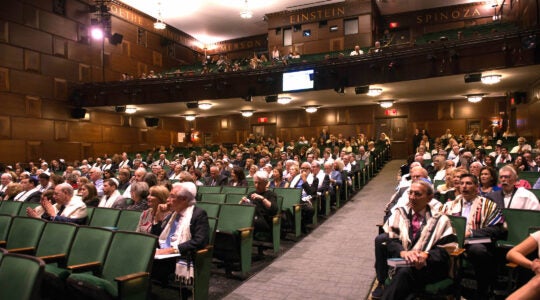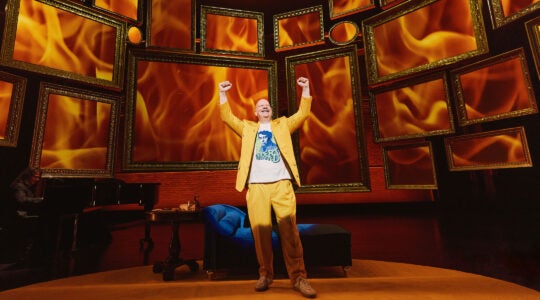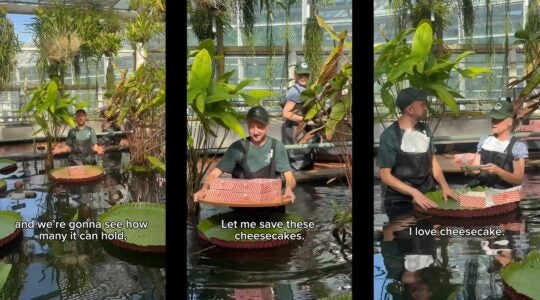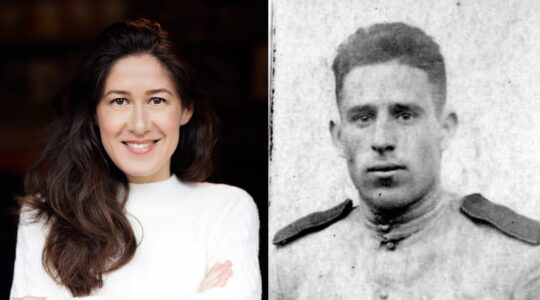In 1999, before the intifada deepened Israeli and Palestinian mutual distrust, Israeli artists Bosmat Alon and Tirtza Even visited the West Bank to shoot a video critical of Israeli policies to curtail Palestinian life.
Introduced by Israeli leftist activists to former political prisoners and ordinary families, Alon and Even spent months in the contested outskirts of Hebron and the cramped streets of the Deheishe camp near Bethlehem.
“The reception we got there was so warm and trusting and real. It went beyond the shells of political identity,” Even said. They eventually realized the true subject of their video was not Palestinians as victims but themselves as Israeli outsiders. “We wanted to document how we felt and what we saw. All we can represent is how we represent them, and expose our layers of discomfort, guilt and detachment.”
Even shot hours of tape of the men describing the demolition of their homes by the Israeli government and acting out Alon’s dreamlike texts about the ambiguities of occupation. But little of this footage made it into their 35-minute digital video “Kayam Al Hurbano (Existing on Its Ruins).”
After “endless and bitter arguments of how to do it right,” Even and Alon instead chose nearly motionless images of bored men loitering and children riding bikes and kicking soccer balls. The muted soundtrack includes only a few fragments of interviews with the former prisoners. Subtle digital manipulations to make walls expand and young boys disappear leave obvious fingerprints on the images. Any overpowering political agenda was left on the cutting-room floor.
“It’s a very strong piece of work that addresses the Arab and Israeli conflict very eloquently,” said Chrissie Iles. The Whitney Museum curator of film and video selected the video in June and considers it a sympathetic work that “raises the issue of displacement, which is very pertinent now.”
“Kayam Al Hurbano” is one of three artworks made by Israeli-born Americans in this year’s Whitney Biennial, the country’s most important survey of contemporary art. (Even has lived in New York since 1989, while Alon lives in Jerusalem.) All three pieces — the other two are a video by Irit Batsry and a Web site by Yael Kanarek — embrace ambiguity and avoid making any grand, definitive statements.
The works contrast with current trends in video art made by Israelis living in Israel, however. There’s a “revival of political and social concerns in Israeli art,” says Sergio Edelsztein, an influential Israeli curator who organized an evening of fiercely sardonic Israeli video art a few weeks ago at a Tribeca gallery.
“My work is concerned with political issues but doesn’t convey them in a didactic way, doesn’t give a lesson and say this is right and this is wrong,” says Batsry, whose video is about a Western filmmaker’s encounter with the foreignness of South India. “I’m more interested in subtleties and the way art reaches the unconscious.”
The quiet lyrical tenor of all three works may say more about trends in the art world than Middle East politics. Throughout much of the 1980s and 1990s, curators favored arresting images and outspoken multiculturalism, but the 2002 Biennial is notable for its absence of angst. “I don’t think my work would have been in two Biennials ago,” Batsry said.
The Biennial includes works about the depth of the abyss between self and homeland made by artists born in Myanmar, Puerto Rico, Mexico, Ireland and China. “The United States is all about displacement and fragmentation,” said Iles, who is from England.
“Enough people are dealing with politics,” said Yael Kanarek. “It takes a particular kind of activity and a particular kind of energy.” Her Web site “World of Awe” (www.worldofawe.net) is one of a half dozen Internet projects in the Biennial. Born in New York in 1967 to an American father and Israeli mother, Kanarek lived in Israel from age 3 to 24, when she returned to New York. Since learning HTML in 1995, she has become one of the most prominent downtown new media artists.
“World of Awe” is an interwoven set of nearly limitless interfaces centered around a cryptic story of a traveler in search of a lost treasure in the digitally rendered desert terrains called Nowheres. Anyone can explore this world by reading the unnamed (and genderless) adventurer’s love letters and journals.
The project began as purposeful escapism, Kanarek says, “because of growing up in Israel. I didn’t want anything to do with politics. I’ve had enough, frankly.” But Kanarek’s childhood in Israel and its layering of modern life and biblical stories sources the timeless desert wanderings of “World of Awe.”
“The relationship between text and place and image is very basic to my understanding of the culture I grew up in,” she said. There’s an almost utopian aspect to her universalist ideas about the global interconnectivity of the Internet, manifested in a Middle East-like setting unmarked by religious and ethnic strife.
Since the Biennial opened March 8, visitors to her Web site have tripled, Kanarek said. She is currently working with an old friend from high school, composer Yoav Gal, on a CD based on the soundtrack of “World of Awe.” And five of her landscapes as well as sculpture and installation will be displayed in an exhibition about art and technology at Exit Art in Soho this fall.
Similarly concerned with process, Tirtza Even has also experimented with a variety of media, transforming “Kayam Al Hurbano” into a CD-ROM, a Web site (www.occupied.org) and a forthcoming text version. The Web site is also a repository of unambiguously critical interviews and other materials that were left on the cutting-room floor.
After seeing “Kayam Al Hurbano,” some of the Palestinians who worked on the project were disappointed that the video wasn’t a hard-hitting indictment of Israeli policy, Even said. In response, the filmmakers gave all the unused raw footage to local activists as “our way of not repeating usurpation, that first we steal their land, then we steal their images.”
Because the relationship between filmmaker and subject often mirrors other power dynamics, the debate over representing the “other” has been ongoing in anthropology for years. Irit Batsry has placed that anxiety at the center of her feature length video “These Are Not My Images (Neither There Nor Here).”
Like much of Batsry’s work, the subject of 80-minute video is perception itself. She interweaves the voices and perceptions of a Western filmmaker, her jaded half-blind guide, and a perturbed local filmmaker in a meandering rumination. Constructed like an essay, the format purposefully alternates from multilayered cinematic collages to portraits of indigenous beauty.
To gain access to certain locales, the narrator signs away her legal rights to her images, yet claims this grants her freedom from ethical questions about her right to use the images she produces of a culture she does not profess to understand.
“I realized this video is not about India itself, but about a place in general and making images of a place,” said Batsry, a self-described “nomad” who was born in Israel in 1957, has lived in New York since 1983 and works internationally. She is currently in Montreal finishing the first phase of a large installation about water, bioethics and Buckminster Fuller.
There are daily screenings of “Kayam Al Hurbano” at 2 p.m. and “These Are Not My Images” at 3:45 p.m. through May 26 at the Whitney Museum, 945 Madison Ave., Man. (212) 570-3676. Hours: Tue.-Thu., 11 a.m.-6 p.m.; Fri., 1 p.m.-9 p.m.; Sat. and Sun., 11 a.m.-6 p.m. $10-$5.
The New York Jewish Week brings you the stories behind the headlines, keeping you connected to Jewish life in New York. Help sustain the reporting you trust by donating today.




